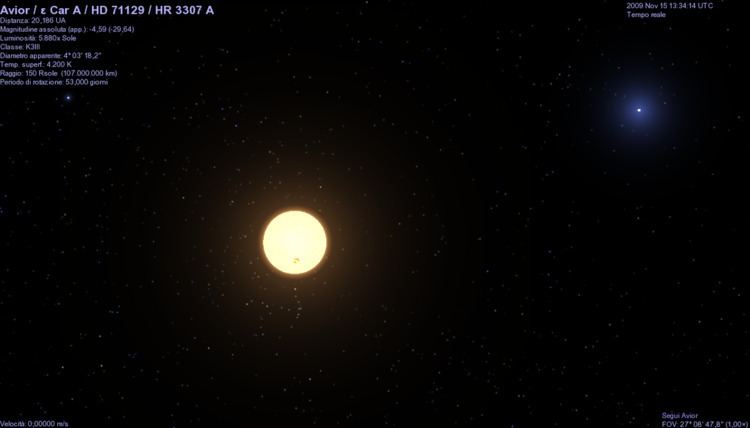 | ||
A B-type main-sequence star (B V) is a main-sequence (hydrogen-burning) star of spectral type B and luminosity class V. These stars have from 2 to 16 times the mass of the Sun and surface temperatures between 10,000 and 30,000 K. B-type stars are extremely luminous and blue. Their spectra have neutral helium, which are most prominent at the B2 subclass, and moderate hydrogen lines. Examples include Regulus and Algol A.
Contents
This class of stars was introduced with the Harvard sequence of stellar spectra and published in the Revised Harvard photometry catalogue. The definition of type B-type stars was the presence of non-ionized helium lines with the absence of singly ionized helium in the blue-violet portion of the spectrum. All of the spectral classes, including the B type, were subdivided with a numerical suffix that indicated the degree to which they approached the next classification. Thus B2 is two tenths of the way from type B (or B0) to type A.
Later, however, more refined spectra showed lines of ionized helium for stars of type B0. Likewise, A0 stars also show weak lines of non-ionized helium. Subsequent catalogues of stellar spectra classified the stars based on the strengths of absorption lines at specific frequencies, or by comparing the strengths of different lines. Thus, in the MK Classification system, the spectral class B0 has the line at wavelength 438.7 nm being stronger than the line at 420.0 nm. The Balmer series of hydrogen lines grows stronger through the B class, then peak at type A2. The lines of ionized silicon are used to determine the sub-class of the B-type stars, while magnesium lines are used to distinguish between the temperature classes.
Type-B stars do not have a corona and lack a convection zone in their outer atmosphere. They have a higher mass loss rate than smaller stars such as the Sun, and their stellar wind has velocities of about 3,000 km/s. The energy generation in main-sequence B-type stars comes from the CNO cycle of thermonuclear fusion. Because the CNO cycle is very temperature sensitive, the energy generation is heavily concentrated at the center of the star, which results in a convection zone about the core. This results in a steady mixing of the hydrogen fuel with the helium byproduct of the nuclear fusion. Many B-type stars have a rapid rate of rotation, with an equatorial rotation velocity of about 200 km/s.
Be and B(e) stars
Spectral objects known as "Be stars" are massive yet non-supergiant entities that notably have, or had at some time, one or more Balmer lines in emission, with the hydrogen-related electromagnetic radiation series projected out by the stars being of particular scientific interest. Be stars are generally thought to feature unusually strong stellar winds, high surface temperatures, and significant attrition of stellar mass as the objects rotate at a curiously rapid rate, all of this in contrast to many other main-sequence star types.
Though the related terminologies are confusingly ambiguous, spectral objects known as "B(e)" or "B[e] stars" are distinct from Be stars since said B(e) entities are in possession of distinctive neutral or low ionization emission lines that are considered to have 'forbidden mechanisms', something denoted by the use of brackets or parenthesis. In other words, these particular stars' emissions appear to undergo processes not normally allowed under current understandings of quantum mechanics. It should be noted that the definition of a "B(e) star" can include objects that are large enough to be in Blue giant and Blue supergiant territory, beyond the size of standard main-sequence stars.
Spectral Standard Stars
The revised Yerkes Atlas system (Johnson & Morgan 1953) listed a dense grid of B-type dwarf spectral standard stars, however not all of these have survived to this day as standards. The "anchor points" of the MK spectral classification system among the B-type main-sequence dwarf stars, i.e. those standard stars that have remain unchanged since at least the 1940s, are upsilon Orionis (B0 V), eta Aurigae (B3 V), eta Ursae Majoris (B3 V). Besides these anchor standards, the seminal review of MK classification by Morgan & Keenan (1973) listed "dagger standards" of Tau Scorpii (B0 V), Omega Scorpii (B1 V), 42 Orionis (B1 V), 22 Scorpii (B2 V), Rho Aurigae (B5 V), and 18 Tau (B8 V). The Revised MK Spectra Atlas of Morgan, Abt, & Tapscott (1978) further contributed the standards beta2 Sco (B2 V), 29 Persei (B3 V), HD 36936 (B5 V), and HD 21071 (B7 V). Gray & Garrison (1994) contributed two B9 V standards: omega For A and HR 2328. The only published B4 V standard is 90 Leonis, from Lesh (1968). There has been little agreement in the literature on choice of B6 V standard.
Chemical peculiarities
Some of the B-type stars of stellar class B0–B3 exhibit unusually strong lines of non-ionized helium. These chemically peculiar stars are termed helium-strong stars. These often have strong magnetic fields in their photosphere. In contrast, there are also helium-weak B-type stars with understrength helium lines and strong hydrogen spectra. Other chemically peculiar B-types stars are mercury–manganese stars with spectral types B7-B9. Finally, the aforementioned Be stars show a prominent emission spectrum of hydrogen.
Planets
B-type stars known to have planets include the main-sequence B-types HIP 78530 b, the subgiants Kappa Andromedae b and a few B-type subdwarfs.
